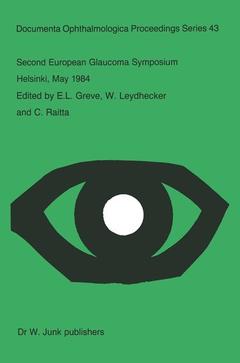Second European Glaucoma Symposium, Helsinki, May 1984 Coll. Documenta Ophthalmologica Proceedings, Vol. 43
Langue : Français
Coordonnateurs : Greve E.L., Leydhecker W., Raitta C.

The European Glaucoma Society was founded in the spring of 1978 at the initiative of Drs Fran~ois, Leydhecker and Greve. Representatives of most European countries met in Ghent and agreed to create a society that would promote the contacts and exchange of knowledge between European glauco matologists. The European Glaucoma Society serves to stimulate glaucoma research and diffuse specific knowledge to general ophthalmologists. The European Glaucoma Society would like to cooperate closely with similar glaucoma organizations in other continents. The first symposium of the EGS was held in April 1980 in Brighton, England. No proceedings were published. The second symposium took place in May 1984 in Hyvinkiiii, Finland. A great number of participants enjoyed a well organized scientific programme of attractive quality. The local organization was in the able hands of Raitta and her colleagues, Raivio and Lehto. The scientific programme was coordinated in Amsterdam where a great amount of work was done by Stella Ompi, secretary to the general secretary. The contents of the meeting have been summarized in this book. This second symposium of the EGS, which took place in an atmosphere of great enthusiasm and friendship, has shown great promise for the future of the European glaucoma.
One: Visual Function in Glaucoma.- Present and future of computer assisted perimetry in glaucoma: selected topics.- Psychophysics in glaucoma. A modified concept of the disease.- Psychological factors in computer assisted perimetry; automatic and semi-automatic perimetry (abstract).- Optic disc densitometric data and delayed VECP in glaucoma.- Correlation or non-correlation between glaucomatous field loss as determined by automated perimetry and changes in the surface of the optic disc?.- Computerized analysis of visual fields.- The visual field quantification issue.- Computerized location of fluctuation changes in glaucomatous visual fields.- The Humphrey Field Analyzer: concepts and clinical results.- Perimetry in congenital and infantile glaucoma.- Computerized perimetric program for detection of early glaucomatous defects.- Early glaucomatous visual field defects in computerized perimetry (Octopus 201) and tangent screen (Bjerrum Kampimetry) (abstract).- Two: Medical Therapy.- Rabbit IOP and vitreous, lens and aqueous weights after various diuretics and water loading test. The influence of optic nerve transection.- Effect of adrenergic agonists and ?1/?2 antagonists on intraocular pressure and adenylate cyclase in rabbit ciliary processes (abstract).- Relative distribution of epinephrine, pilocarpine and timolol in the rabbit eye.- Location of ?-adrenergic receptors in the cornea and ciliary body of the rabbit (abstract).- Effect of ocular pigmentation on ocular disposition, metabolism and biophasic availability of pilocarpine.- The comparative ocular responses of pilocarpine ophthalmic rods and pilocarpine eye drops.- The influence on the capillary blood volume of the optic nerve head exerted by beta-blocking agents with and without intrinsic sympatomimetic activity.- (—)-propanolol in the isolated rabbit iris.- Comparison of different ?-blockers in open angle glaucomas.- The effect of d-timolol on intraocular pressure in patients with ocular hypertension (abstract).- The effects of timolol use in glaucoma patients under the age of 17 years.- Levobunolol: Minimum concentration required to control IOP in subjects with primary open-angle glaucoma or ocular hypertension (abstract).- Long-term treatment of chronic open angle glaucoma with topical Pindolol 1%.- Maximal medical treated glaucoma patients.- Levobunolol: A new beta-adrenoceptor antagonist for the treatment of glaucoma (abstract).- Eye irritation caused by topical beta-blocker therapy. A new methodological screening approach.- Three: Laser Treatment.- Laser trabeculoplasty.- Computerized perimetry before and after trabeculoplasty. A study of the short-term effect.- Effect of Argon laser trabeculoplasty in open angle glaucoma: our experiences.- Argon laser trabeculoplasty. Variation of methods and immediate complications.- Early and late effects intraocular pressure of the treatment mode of laser trabeculoplasty.- Gonioretraction vs. trabeculoplasty.- Cyclotrabeculospasis — a new and simple method of laser treatment in glaucoma.- The immediate IOP responses after neodymium YAG laser iridotomy in the human eye (abstract).- Argon laser trabeculoplasty in chronic open angle glaucoma.- Laser-prophylaxis of neovascular glaucoma.- Ocular effect of neodymium-YAG laser (abstract).- Argon laser trabeculoplasty after trabeculectomy.- Experimental and clinical laser iridectomy with Argon and Nd YAG Q switched laser.- Four: Surgical Treatment.- Surgery and its documentation in glaucoma.- Scleral changes after diathermy and incision (scanning electron microscope study).- Long-term observations on goniotrephination.- Ten year prospective follow-up of a glaucoma operation. The Double Flap Scheie in primary open angle glaucoma.- Long-term observations after trephination with scleral-flap in glaucoma with treatened point of fixation.- Valve trabeculotomy and filtering iridocycloretraction in glaucoma.- A new approach for chamber angle surgery.- Gonioscopic trabeculectomy. First results.- Experimental and clinical consideration of direct cyclodiathermy.- Research on the mechanism of trabeculectomy: the main pathway of the aqueous humor.- The trabeculo-keratencleizis under scleral flap.- A modification of Cohan’s filtering corneal trephination (abstract).- Five: Miscellaneous Subjects.- Variation in anterior chamber volume during the pilocarpine/phenylephrine provocative test.- Unilateral angle closure glaucoma: a biometric study.- Limbal and axial chamber depth. Variations. Detection of primary angle-closure glaucoma (abstract).- Value of ultrasonographic biometry in congenital glaucoma.- Astigmatism and amblyopia in congenital glaucoma.- Hereditary juvenile glaucoma.- Chronic open-angle glaucoma with exfoliation syndrome. Long-term functional prognosis of treated and regularly followed patients.- Baring of the optic disc circumlinear vessels in ocular hypertension and glaucoma.- Glaucomatous alterations of the optic disc in high myopia.- Orbital haemodynamics and aqueous humour dynamics in diseases of the carotid-cavernous and vertebro-basilar systems.- Panretinal photocoagulation treatment of severe, complicated glaucoma (abstract).- Hemorrhagic glaucoma after intraocular operations.- Blood and plasma viscosity measurements in glaucoma patients (abstract).- Secondary glaucoma in reactive lymphoid hyperplasia of the conjunctiva and uveal tract.- The natural course of open angle glaucoma (poster exhibition).- Goniodysgenesis in elderly glaucoma and non-glaucoma patients. A masked biomicroscopic study of the anterior segment (abstract).
Date de parution : 10-2011
Ouvrage de 380 p.
15.5x23.5 cm
Disponible chez l'éditeur (délai d'approvisionnement : 15 jours).
Prix indicatif 52,74 €
Ajouter au panierThème de Second European Glaucoma Symposium, Helsinki, May 1984 :
Mots-clés :
© 2024 LAVOISIER S.A.S.



